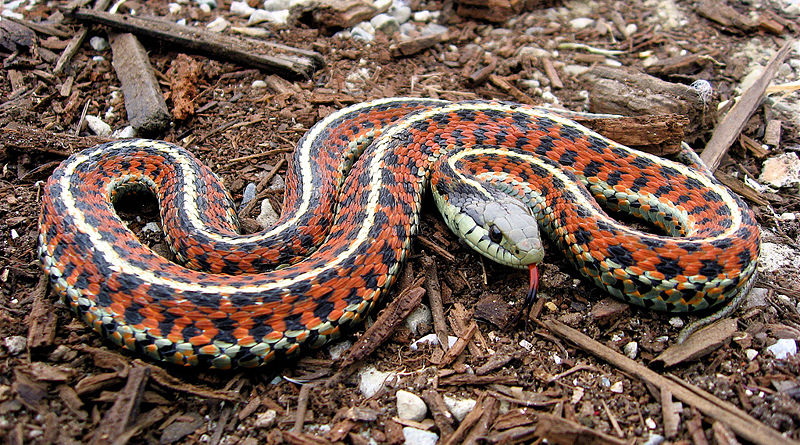Please see Parts I, II and III of this article for more on garter snake care.
Diet
In the wild, most garter snakes are opportunistic feeders…even road-killed frogs are taken on occasion (please see Part I).
While most mammal-feeding snakes thrive on rodents alone, in my experience garter snakes do much better when fed a varied diet. This quirk in their husbandry may explain why captives often fail to live as long as might be expected.
Always provide a wide range of foods to your garter snakes. Earthworms, goldfishes and minnows can form the basis of the diet of most, but individual preferences vary (see species accounts).
Several young common garter snakes under my care relished the grubs of wood-boring beetles, while others refused them. Smaller species (i.e. Butler’s Garter Snake) often accept insects and slugs.
Garter snakes may be immune to the toxins of amphibians found in their habitats, but not to those of related species. An aquatic garter snake that can safely feed upon California newts, for example, might be killed upon consuming a Red-spotted Newt.
Garter snakes have fast metabolisms (as snakes go!). Youngsters and gravid females should be fed every 3-4 days; adults every 5-7 days.
Common Garter Snake, Thamnophis sirtalis
Twelve subspecies of this most frequently kept of the garter snakes range from southern Canada into Mexico. In the continental USA, it is absent only from New Mexico and Arizona….I know of small populations living in the heart of NYC.
The Eastern Garter Snake (T .s. sirtalis), exhibits the typical yellow-striped, black- spotted garter snake pattern. Individuals vary widely, however…I’ve come across quite bland and nearly black individuals. Exceptionally large specimens may approach 4 feet in length, but 24 inches is typical.
Some common garter snake subspecies are considered among the most attractive of all North American snakes. The Red-sided (T. s. parietalis) Florida or Blue-striped (T. s. simlis) and, especially, the San Francisco (T. s. tetrataenia) Garter Snakes are particularly colorful.
Butler’s Garter Snake, T. buttleri
With an average adult size of 15-18 inches, Butler’s Garter Snake is ideally suited to planted, naturalistic terrariums. It occupies a range of habitats in the north-central USA and southern Canada, and calms down quickly in captivity.
Aquatic Garter Snake, T. couchi
Aquatic Garter Snakes are always found near water (Oregon to Mexico), where they bask on protruding stumps in the manner of the closely-related water snakes (Nerodia spp). The Giant Aquatic Garter Snake (T. c. gigas) approaches 5 feet in length. Aquatic Garter Snakes add fish eggs and leeches to their diets on occasion.
Plains Garter Snake, T. radix
The emergence of thousands of plains garter snakes from hibernation is a tourist attraction in parts of southern Canada. A toad specialist, captives adapt quickly to a diet of fishes and earthworms.
Western Terrestrial Garter Snake, T. elegans
 This species adds a few twists to typical garter snake husbandry – it readily consumes mice and other snakes (including its young), and unreceptive females have been reported to kill over-enthusiastic males.
This species adds a few twists to typical garter snake husbandry – it readily consumes mice and other snakes (including its young), and unreceptive females have been reported to kill over-enthusiastic males.
Eastern and Western Ribbon Snakes, T. sauritus & T. proximus
These thinly built snakes occupy nearly all of the USA, with the Western species reaching Costa Rica. I have never encountered them far from water, into which they retreat when startled. Captives fare best on a diet of fish and crayfish.
Further Reading
You can read more about the natural history of the Eastern Garter Snake here.
Garter Snake Eating Frog image referenced from wikipedia and originally posted by Cjottawa
Coastal Garter Snake image referenced from wikipedia and originally posted by Steve Jurvetson
 That Reptile Blog – Reptile, Amphibian and Exotic Pet Care and Information
That Reptile Blog – Reptile, Amphibian and Exotic Pet Care and Information
